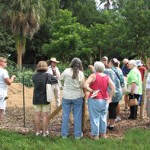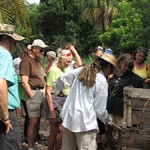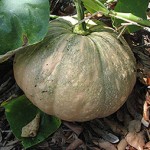The No Till No Dig Way: Gardening 101, It’s Easy, Really!
- Composting Class 2010
- Observing The Compost
- Seminole Pumpkin On the Passive Compost Pile
I made a new friend who is not yet gardening and was rather intimidated by it and quite sure it would take him a long time to learn how to grow food. He mentioned to me that he thought he should take a Gardening for Dummies Class, and that what I had to offer was probably too advanced to help him.. Hey! Not true!
I might have felt frustrated because he came to me with a set of concrete beliefs about gardening and the difficulties he might encounter and the likelihood that he would fail. This is faith y’all: I am excited to help because I know he will not fail, and not only would I be teaching him to garden (which is the easy part) I would also be smashing concrete beliefs! Now that’s powerful!
Heathcote Botanical Garden’s No Till Organic Garden grows food for a local food bank in Fort Pierce. In addition to organizing the efforts of the other volunteers at Heathcote Botanical Garden’s No Till Organic Garden, I present classes there that take participants through a year in the organic garden, starting with composting, and going on to making a plan (always a good idea), building a lasagna layer mound for gardeners starting suddenly without preparation, and continuing on with minicourses about watering and trellising, moving into harvesting, natural backyard ecosystems, and planning for summer crops or fallow gardens, and now Nan Billings, the Children’s Education Coordinator at Heathcote and I are, for the first time presenting cooking in the garden courses for people who want new ideas on how to prepare their home grown and often exotic subtropical food.
My point in telling all of this is that these classes taken in sequence set a gardener up for easy success in the garden no matter whether they are just starting out in the garden or have plenty of experience. Furthermore, volunteering at the No Till Organic Garden at Heathcote is an excellent way to learn without taking classes. Most of the volunteers who are working with me are now growing in their home gardens in the same no till way as we grow at Heathcote’s No Till Organic Garden. Several never grew food before and are succeeding beautifully at home, and several others grew food at home in another fashion and are adopting some no till methods to their home gardens. This is because no till growing is easy. It is easy because it uses natural systems to grow plants, systems that already exist in nature. We are not manipulating or bending nature to our needs we are simply rediscovering the way that plants and soil have interacted successfully since the dawn of green on earth, and allowing those systems to grow our food for us. It is not the end of work, but it is the end of unnecessary back breaking work, and it is very successful, and environmentally friendly. We use no fertilizer and no pest sprays at all, ever. So there is no chance of run off, polluting, or poisoning ourselves. We don’t till, or turn the soil so there is no burst of fertility and no chance of soil erosion or nutrient run off from plowing.
There is an important mind set that goes along with this more natural no till method of growing and the mindset is also an important component of this method in that it saves us from making missteps that come out of frustration or fear of failure. We agree to accept some failures, but we don’t think of them as failures we consider them part of the system, or part of our learning experience. We accept that insects will share our food, and we agree not to do battle. We plant redundancies so that we can afford to share. We plant long beans, lima beans, and black eye peas in the summer. We may lose some beans to insects, but we will still get a bountiful harvest. We plant pigeon peas, bitter melon, loofah, watermelon, winter melon, seminole pumpkin, collards, mustards, broccoli, radishes, and kohlrabi, arugula, lettuce, carrots, onions, nasturtiums, borage, eggplant, peppers, tomatoes, potatoes, okra, basil, amaranth, dill, and pineapples. All of this attracts insects and the insects that eat insects. There are very few plant casualties this way, and we are all prepared for the losses we may incur. Plants we lose to insects we call food for soil. Nothing that happens in our garden is really considered a failure. As a thank you for this method we often get to observe insect predators at work. If you have never watched a wasp extract a caterpillar from its hole in a plant stem and fly off with it you don’t know excitement! We have seen this happen over and over again, and it always causes a ruckus in the garden as if it were the first time.
I passed my card to my new friend, I am hoping his desire to grow food at home will overpower his concerns that he might fail. If you have similar concerns and these worries keep you from trying a garden at your place, or if you have tried your hand at gardening before and felt you were unsuccessful I urge you try again. Really you have nothing to lose. Your life does not depend on this activity, and should you succeed (yes you will!) the reward is indescribable. Fresh food from your yard and by your efforts is a far finer dish then any you can pick up at the store. If you need some help, I am just a phone call away.




7 Responses
The no till method only work if there are no persistent deep-rooted weeds in the area. Florida natives such as Florida betony, cat briar, blackberries and poison ivy plus invasives such as torpedo grass and wild taro will grow through that deep layer of mulch in a heartbeat.
Thanks for your comment Ginny. With weeds below it is customary in the no till method to make the bottom layer cardboard or 1/4″ of newspaper. This is not theory. I have done this over and over again here in South Florida, and not just in my yard. The same principles apply no matter where and what the circumstances. This is a constant.
I guess there will always be pros and cons. But, you make a very strong case for choosing the no till method, Adina.
Neat post ….. something I hadn’t ever thought about! Gives us novice or frightened gardeners confidence! Thanks!
Hi Adina, I am layering some no till beds and I must say things are growing much better thru the drought times. That cardboard really holds the moisture and nutrients like a sponge and the plants really like it .
Holding moisture is what its all about… that and feeding the organisms that create the nutrients.
Thanks for your comments Sara and Dorothy.
Thanks for your comment Suz. I am glad to hear you are growing through the summer and employing some layered gardens.